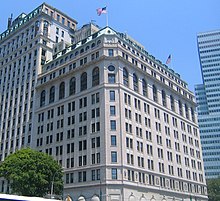




Edward Hale Kendall (July 30, 1842 – March 10, 1901) was an American architect with a practice in New York City.[3]
Born in Boston, Massachusetts, Kendall was one of the first generation of Americans to study in Paris; he apprenticed in the office of the construction engineer Gridley James Fox Bryant, Boston. He moved to New York where he collaborated with Bryant's collaborator in developing Boston's Back Bay, Arthur Gilman, in building the Equitable Life Assurance Society Building (1868–71). He soon established independent practice and was a member (1868) and eventually President (1892–93) of the American Institute of Architects, in which capacity he presided over the AIA conventions held during the World's Columbian Exposition, Chicago 1893.[4]
After the humiliating defeat of an Act to License the Practice of Architecture in New York (1892), The Tarsney Act of 1893,[5] by which the Federal Government was to hire private architects through competitions, was passed by Congress largely owing to his persistence as president of the American Institute of Architects.
Kendall died in New York City, New York in 1901.
All works were in New York, unless otherwise noted.
| International |
|
|---|---|
| National |
|
| Artists |
|
| People |
|
| Other |
|